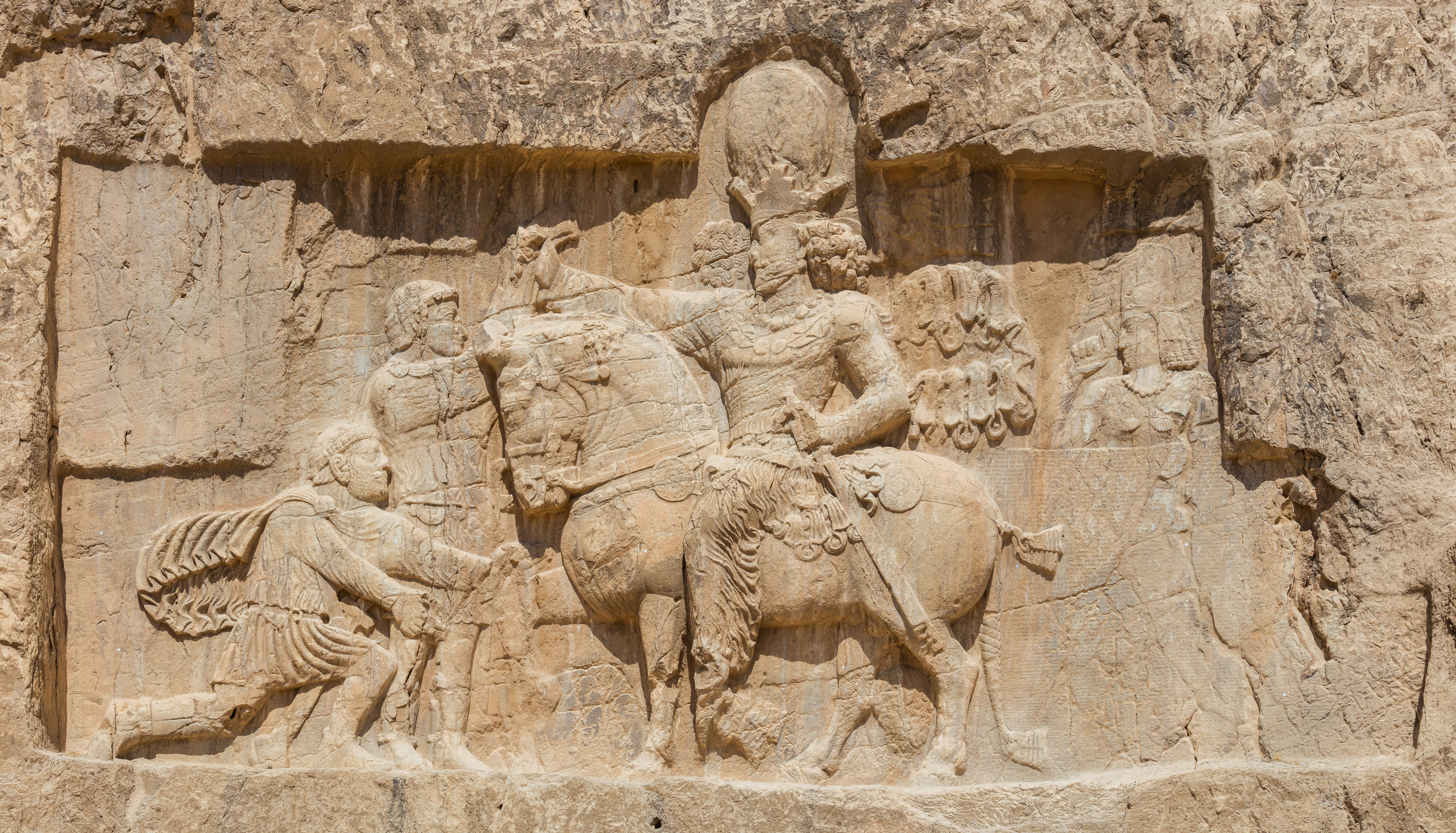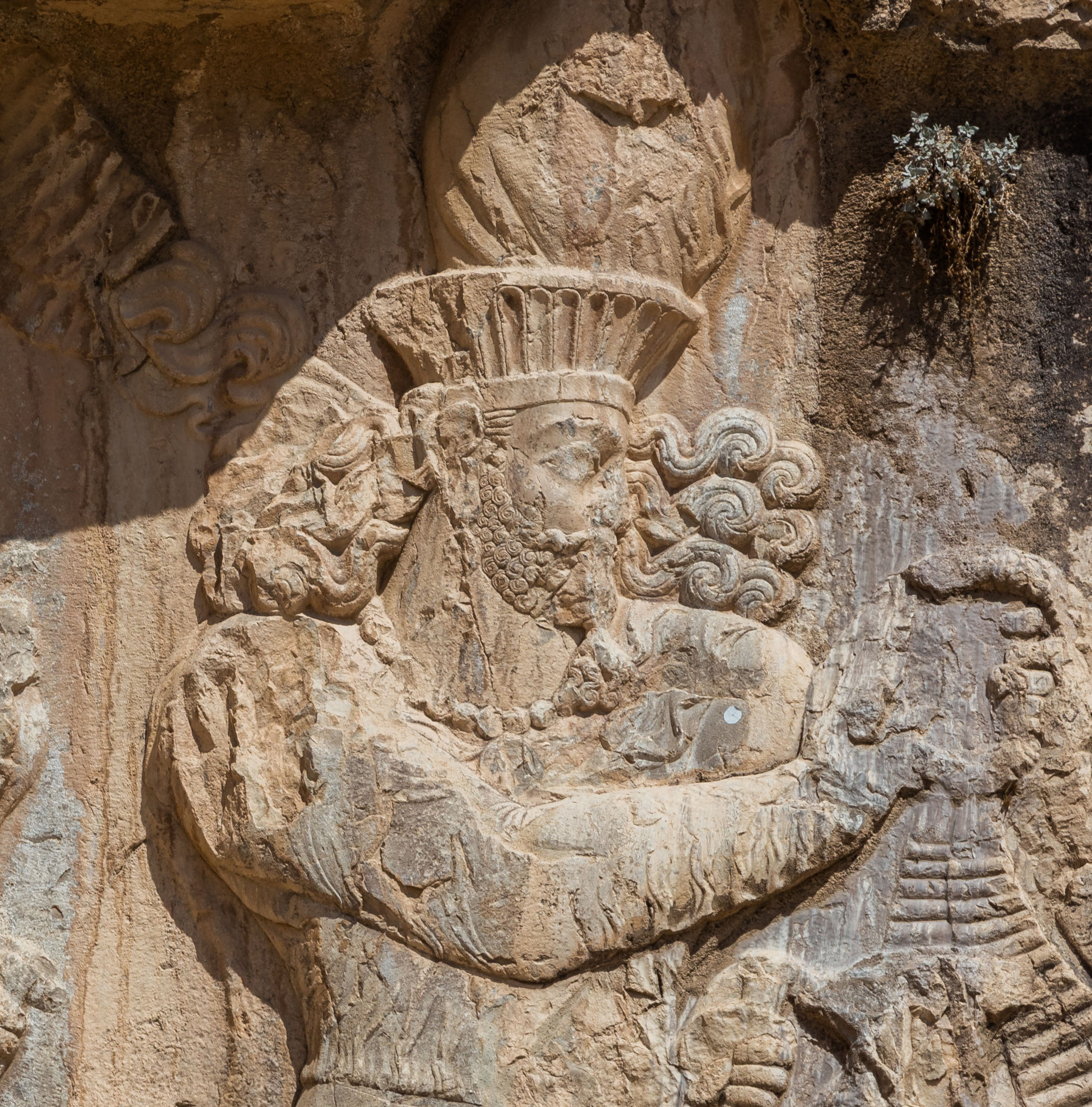Kingship
The theme of kingship pervades the Near Eastern corpus. From Gilgamesh and Sinuhe to Zoroastrian and Abbasid literature, a diverse range of texts comment on the role of the king in society, the nature of royal power, and the relationship between the king and his subjects. The Sasanian inscriptions are no exception. Shapur and Narseh's inscriptions speak to the sources and characteristics of imperial power. Kerdir's inscription reflects upon servantship and offers a commoner's perspective of the royal office. Below are in-depth analyses of the different aspects of kingship touched upon within these texts.
"King of Kings"
A Sasanian king was not merely a king, but the shahanshah--the "king of kings". The rulers of every Persian empire took on this title, which asserted that they were not only superior to their own people, but to every monarch on Earth. The Achaemenids might have had the strongest claim to genuine world rule, but what is intriguing about this title is that it presupposes the existence of empire. A "king of kings" must rule other rulers, which means he must control other states. The opening lines of Narseh and Shapur's inscriptions reinforce this notion. Both kings list their titles, the first of which is shahanshah of the Persian and non-Persian worlds: "I, the Mazda-worshipping god Shapur, king of kings of Iran and Aneran (not-Iran). . ." // "[I am the Mazdaean Majesty Narseh] King [of Kings] of Iran and Aneran." Every mention of a king's name in Kerdir's inscription is accompanied by "king of kings." Sasanian kingship projected itself far beyond Iran and carried imperial connotations. Semantics aside, the title of shahanshah illustrates just how large the image of the king loomed in the Sasanian consciousness.

Royal Power
Shapur and Narseh's inscriptions shed light on the foundations of royal power and what constitued legitimate kingship in the Sasanian world. Sasanian kings appealed heavily to divine authority. For instance, both Shapur and Narseh make reference to Ahura Mazda before listing their other titles (shahanshah etc). Shapur gives his name as "the Mazda-worshipping god Shapur, king of kings" and Narseh gives his name as "the Mazdaean majesty Narseh, king of kings." Both kings also make reference to their divine lineage: Shapur calls himself a god outright, and Narseh calls himself a "king. . . whose origin (is) from the gods." This shows that claims to spiritual preeminence helped to legitimize kings' temporal authority. At the same time, the Sasanian kings still considered themselves subordinate to the gods. In his inscription, Shapur attributes all of his success to divine favor: "the gods made me their ward in this way, and with the support of the gods I acquired and possess these so numerous lands" (31). This move suggests that the Sasanian kings had a strong religious imperative and were limited to acting within the confines of the Zoroastrian faith.
Narseh's inscription demonstrates that kingship also derived legitimacy from the people. Bahram III was the legitimate successor to his father, Bahram II, but his rule was undermined by the dissenting nobility. On the other hand, Narseh successfully contested the throne by gaining the support of the aristocracy and winning the loyalty of dignitaries, whom he quotes as writing thus: "If we knew. . . someone [who would be more suitable for ?] the rulership(?) [than?] Your Majesty, [(then) he should be king ?] / “But we know [that there is not(?). . . the rulership suits (you)." (39-40) Although Narseh might have traditionally been considered a usurper, public support allowed him to contest Bahram's birthright, change the narrative, and cast Bahram as the usurper. By no means was the Sasanian system democratic, but Narseh's inscription shows that royal recognition was earned, not deserved.
Narseh's inscription demonstrates that kingship also derived legitimacy from the people. Bahram III was the legitimate successor to his father, Bahram II, but his rule was undermined by the dissenting nobility. On the other hand, Narseh successfully contested the throne by gaining the support of the aristocracy and winning the loyalty of dignitaries, whom he quotes as writing thus: "If we knew. . . someone [who would be more suitable for ?] the rulership(?) [than?] Your Majesty, [(then) he should be king ?] / “But we know [that there is not(?). . . the rulership suits (you)." (39-40) Although Narseh might have traditionally been considered a usurper, public support allowed him to contest Bahram's birthright, change the narrative, and cast Bahram as the usurper. By no means was the Sasanian system democratic, but Narseh's inscription shows that royal recognition was earned, not deserved.
Defender of Church and State
As alluded to above, the king was principally a defender of the faith. Kerdir attests that his religious enterprises--establishing Wahram fires, making Magi "content and prosperous", and chartering said fires and Magi--were done "at the command of Shapur" and the other kings. Shapur confirms this by boasting that "many Bahram fires have been established by me, many good Magi ordained, and the cults of the gods made great." Shapur's apparent pride in these undertakings suggests that the king was expected to generate momentum for religious policy and to serve as an exemplar of piety and worship.
The king was also a defender of the state. In his account of the Syrian campaigns, Shapur asserts that the enemy was the aggressor in every encounter. Of Gordianus, he writes, "Gordian Caesar drew together an army. . . and to Asurestan (=Babylonia) he came against Iran and [against] me" (6). Of Phillip Caesar: "[he] lied again [and] did harm to Armenia" (9). Of Valerian: "[he] came against me" (18). Though Shapur was surely motivated by conquest, phrases like "he came against Iran" or "did harm" give the impression that Shapur went to war to fufill his duty as protector of the realm. Kerdir's inscription shows how the king's duties to church and state would occasionally intersect. For instance, Kerdir relates how "at the command of the king of kings, I did not let [the empire's fires and Magi] be harmed or taken as booty, and those which anyone had thus taken as booty I took and allowed them back to their own land" (15). To the Sasanian kings, protecting religious establishments was as much a matter of piousness as domestic security. The clearest testament to the king's defensive duties comes from the Paikuli inscription, in which the nobility petition Narseh to take the throne and secure the state: "May the King of Kings graciously move from Armenia hither to Ērānšahr. . . [And may he keep? Ērān?]šahr safe(?) until the last!" (8)
The king was also a defender of the state. In his account of the Syrian campaigns, Shapur asserts that the enemy was the aggressor in every encounter. Of Gordianus, he writes, "Gordian Caesar drew together an army. . . and to Asurestan (=Babylonia) he came against Iran and [against] me" (6). Of Phillip Caesar: "[he] lied again [and] did harm to Armenia" (9). Of Valerian: "[he] came against me" (18). Though Shapur was surely motivated by conquest, phrases like "he came against Iran" or "did harm" give the impression that Shapur went to war to fufill his duty as protector of the realm. Kerdir's inscription shows how the king's duties to church and state would occasionally intersect. For instance, Kerdir relates how "at the command of the king of kings, I did not let [the empire's fires and Magi] be harmed or taken as booty, and those which anyone had thus taken as booty I took and allowed them back to their own land" (15). To the Sasanian kings, protecting religious establishments was as much a matter of piousness as domestic security. The clearest testament to the king's defensive duties comes from the Paikuli inscription, in which the nobility petition Narseh to take the throne and secure the state: "May the King of Kings graciously move from Armenia hither to Ērānšahr. . . [And may he keep? Ērān?]šahr safe(?) until the last!" (8)
